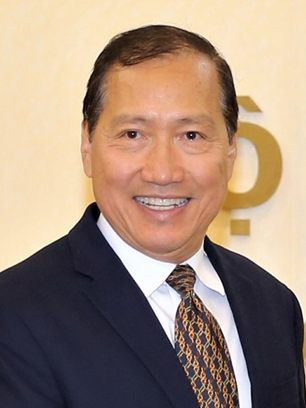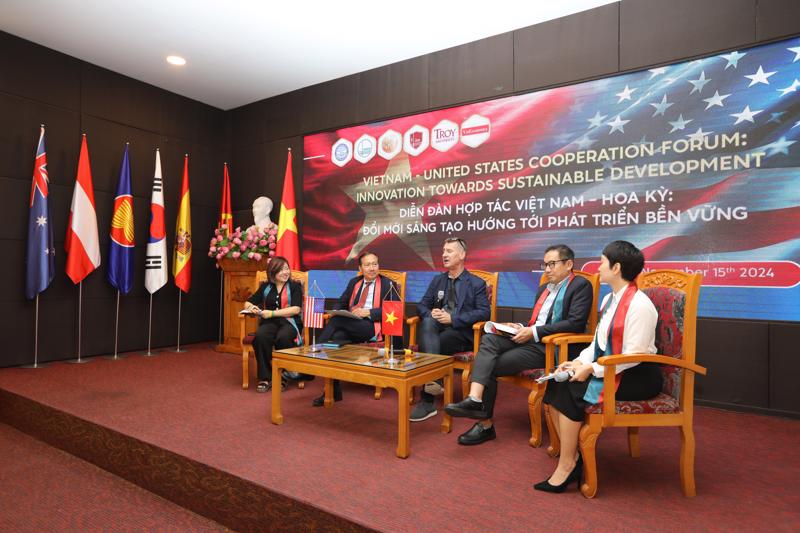
Professor Andreas Hauskrecht, Kelley School of Business, Indiana University (US)
Vietnam’s economy is undeniably a huge success story, with its focus on exports and world market integration serving as a model. However, the economy is biased toward international trade, to an extent unseen in human history.
This represents an entirely new dimension. A level of openness where international trade equals nearly 200 per cent of GDP is unprecedented. Even 100 per cent would be extremely high. We have only seen such levels in export-import hubs like Singapore or Hong Kong (China), but not for a territorial state. This makes Vietnam highly vulnerable to international turbulence.
I am not opposed to international trade. I support world market integration, but Vietnam’s economy is so dependent on trade that external shocks can have a significant impact. The Trump administration, for example, could trigger such an exogenous shock. Vietnam not only has a high degree of openness, but also a substantial trade surplus with the US.
This trade surplus exceeds $100 billion, representing about 20-25 per cent of Vietnam’s GDP. A high surplus typically ranges from 3-5 per cent. I have never seen such a level in any country, at any time in history. So, while I support global market integration, Vietnam’s economy is dangerously skewed towards trade, particularly with the US.
It is important to note that the Biden administration maintained most of the tariffs put in place by the Trump administration. This makes Vietnam highly vulnerable to potential policy changes from the US. What concerns me further is that, as a free trader, I can mathematically prove trade is not a zero-sum game. Trade benefits all parties involved, as established by trade theory since 1817.
The problem is that the new administration views trade as a zero-sum game. In this context, a trade surplus with Vietnam is seen as taking jobs and production away from the US. This is economically nonsensical. The exact level of tariffs is unknown, but it is likely they will be at least 20 per cent for all trading partners. Such measures could severely harm Vietnam’s economy.
In the short term, Vietnam is highly exposed to global and US economic shifts, as well as American policy reactions.
Looking ahead, it cannot rely so heavily on FDI. Let me clarify: I’m not against FDI. I’m a free-market economist, and such investment is vital. However, the sheer scale of FDI’s contribution to Vietnam’s exports is disproportionate, and a strategic shift is needed, which is moving from external demand-driven exports to fostering domestic demand.

Mr. Henry Vo, Managing Partner of VABA Venture Capital and Managing Director of the Vietnamese American Business Association (VABA)
The Vietnamese-American community is one of the four largest Asian communities in the US. Its growth creates a significant opportunity for Vietnam. In California, with a population of around 39 million, there are 6 million Asian Americans. Of the 2.5 million Vietnamese Americans in total, approximately 52 per cent reside in California. This community represents a built-in market demand for Vietnamese products, providing an ideal opportunity for Vietnamese companies entering the US market.
Additionally, from 1993 to 2024, Vietnamese Americans have sent back between $14 billion and $19 billion annually to Vietnam. Over this period, nearly $190 billion was remitted, matching the total amount of FDI disbursed to Vietnam in the same timeframe.
Vietnam’s small and medium-sized enterprises (SMEs) can also tap into the US market, particularly in areas like software development. Vietnam has a young, tech-savvy population playing a key role in the country’s rapidly-growing IT sector, including software development and outsourcing solutions. The e-commerce market in Vietnam is also booming, making it crucial for SMEs to invest in technology, build a strong digital presence, and explore new digital channels such as websites and social media.
Before establishing a physical presence in the US, SMEs can start by building an online presence. Since 2018, platforms like Amazon and Walmart have enabled global online markets. These platforms provide an excellent channel for Vietnamese SMEs to reach US consumers.

Professor Nguyen Dinh Duc, Vice President of the Vietnam Association of Mechanics and Director of the Laboratory for Advanced Materials and Structures, University of Economics and Business, Vietnam National University
Building a comprehensive ecosystem is essential for Vietnam to engage in semiconductor chip design. However, the critical question is whether it is capable of participating in all aspects of the process. Chip production involves several stages: design, fabrication, testing, packaging, and distribution. Given the extremely high costs associated with fabrication, Vietnam should strategically focus on areas like design, packaging, and testing, which align with our identified strengths as educators and scientists.
To realize this vision, the first step is to develop educational programs that meet global standards. Currently, over 30 universities in Vietnam offer undergraduate and postgraduate programs related to semiconductors. Second, there is a pressing need to train academic staff at these institutions. While Vietnam has experts in chip and semiconductor design, their numbers remain insufficient. Third, substantial investment is required in facilities for chip design, packaging, and testing, as the current infrastructure in universities is still inadequate. Achieving this will require policy support from the government and significant investment from businesses. Lastly, scholarships for students in this field are vital to fostering talent, as semiconductor design requires highly-skilled professionals with a deep understanding of the technology. Building a robust ecosystem will necessitate close collaboration between the government, academic institutions, and enterprises, particularly large corporations.
Regarding educational collaboration between Vietnam and the US, this is an excellent time to strengthen ties. We can learn from the experiences of Japan and South Korea, two countries that have risen to global prominence by leveraging science and technology. For Vietnam to achieve its aspirations of becoming a strong and prosperous nation, it must rely on technological advancement.
A critical component of this journey is workforce development. We hope to gain greater support from US universities. While the Vietnam National University, Hanoi, already collaborates with US faculty members, we aim to deepen this partnership. Beyond online training, hands-on opportunities for Vietnamese lecturers in world-class laboratories are essential to acquiring the latest technologies, which they can then share with students. Additionally, we seek US assistance in strengthening university governance and management in Vietnam to elevate the overall quality of higher education.

Dr. William J. Carroll, President of Hunter Global Education
Two decades ago, we were invited to collaborate on initiatives to establish international education programs in Vietnam. What I want to emphasize is the importance of teaching students critical thinking skills, enabling them to tackle challenges in their professional and personal lives. While each institution has its own resources, these alone are insufficient to meet broader educational demands.
In practice, the collaboration between Vietnamese and American institutions has yielded significant success, particularly in STEM education (Science, Technology, Engineering, and Mathematics). This is a strategic focus that no single institution can accomplish independently.
Vietnam and the US should take advantage of this opportunity to collaborate and share resources, ensuring mutual benefits while advancing their respective goals. This perspective reminds us of the importance of solidarity and coordinated efforts to address shared challenges.

Ms. Tashina Giraud, Director of International Partnerships and Strategic Initiatives, American University (US)
Technology is reshaping career paths for business administration students, extending beyond the traditional STEM (Science, Technology, Engineering, and Mathematics) fields. Students must go beyond simply being familiar with technology; they need to actively engage with it and develop proficiency.
At our university, we have integrated technological competencies into the curriculum. Incorporating STEM elements into a business program not only enriches the education but also attracts a distinct and diverse group of students. For example, in disciplines like marketing, business analytics, and related fields, we have infused STEM concepts to enhance the learning experience.
This innovative approach has proven effective in drawing more students to our programs. In the US, universities are actively adapting their courses to stay competitive and relevant, and Vietnam might benefit from exploring similar strategies. By equipping students with both business and STEM skills, they gain a robust foundation to contribute meaningfully to their country’s progress. From our observations, students involved in STEM-integrated programs demonstrate superior analytical abilities and excel in data-driven tasks.
Even workforce training institutions in the US are now embedding STEM education into their offerings. Moreover, we utilize AI assistants to support students, providing them with practical tools that enhance their learning. Our programs are evolving to keep pace with technological advancements, with a particular focus on the transformative role of AI.

Mr. Michael Nguyen, Managing Director of Boeing Vietnam and Vice Chairman of the American Chamber of Commerce in Hanoi (AmCham Hanoi)
Vietnam is among the fastest-growing markets in the region, with annual GDP growth averaging around 7 per cent and a population of approximately 100 million, half of whom are under the age of 30. This demographic and economic profile makes Vietnam an attractive and highly-promising market for businesses across various sectors. It also presents a valuable opportunity for US companies, particularly those specializing in high-tech manufacturing, to establish a strong presence.
Vietnam has actively engaged in numerous free trade agreements with global partners while focusing on improving the skills of its workforce to position itself as a manufacturing and production hub in Southeast Asia and globally. The aviation sector, in particular, has seen significant investment, with companies like Boeing proud to be among the first to establish a foundation in this market. Over the years, our partnership has achieved notable success, but it has also highlighted key challenges for foreign businesses entering Vietnam.
According to a recent survey conducted by the AmCham Hanoi, regulatory and legal complexities, as well as issues surrounding clean energy, are critical concerns for attracting high-quality enterprises to Vietnam. In practice, Vietnam’s legal framework remains relatively intricate, and the approval process for foreign investment projects can be lengthy. Moreover, foreign businesses are paying close attention to the training and development of Vietnam’s young workforce.
The Vietnamese Government has been proactive in implementing measures and policies to address these challenges. However, policies need time to fully demonstrate their effectiveness. I am confident that the government’s ongoing efforts will create a solid foundation for Vietnam to achieve its ambitious development goals in the future.

Ms. Bui Kim Thuy, Member of Harvard Advisory Board - Asia Pacific (ABAP)
One of Vietnam’s biggest challenges in attracting FDI from the US in recent years is corruption. Many US investors remain cautious and concerned about this issue when considering the Vietnamese market. However, recent years have shown a strong commitment from Vietnam’s leadership to address this problem decisively. These efforts offer hope that the government’s initiatives will create a more transparent and favorable investment environment, further encouraging high-quality FDI inflows.
The second issue, in my view, is the protection of intellectual property (IP) rights, particularly in the technology sector. Vietnam has received criticism for its shortcomings in managing copyright and IP protections. At the same time, the skill level of the Vietnamese workforce remains a concern. Without sufficient upskilling, it will be challenging to attract and retain foreign investors.
Another significant hurdle is the country’s administrative procedures. Many businesses report dissatisfaction with the lengthy approval processes for investment projects, especially at the local government level. These delays can be a major deterrent for investors seeking efficiency and predictability.
From my perspective, conversations around investment tend to focus narrowly on projects within Vietnam. I believe we should expand our outlook to consider investments for Vietnam, transcending geographic limitations. Investments in Vietnam are often assessed by tangible factors like the number of factories or workers. However, with modern technological advancements, businesses and corporations are increasingly prioritizing intangible metrics to evaluate their success.

Ms. Bui Thi Viet Lam, Country Representative of the US-ASEAN Business Council (USABC)
USABC members are confident in the vision of positioning Vietnam as an innovation hub in Asia by 2030. As a result, we have been actively supporting Vietnamese businesses in fostering innovation in recent years. Companies like Meta, Google, and Amazon are working closely with the government, government partners, and private enterprises to advance innovation. Meta, for example, has organized multiple competitions to identify and cultivate innovative talent in Vietnam.
Vietnam’s innovation index has consistently improved over the years, making the country an increasingly attractive market for US companies. In 2024 alone, senior leaders from major US firms like Apple and Meta visited Vietnam, indicating their strong interest in the market. These companies are also considering the possibility of establishing semiconductor assembly plants in Vietnam.
From my perspective, Vietnam has great potential in the semiconductor sector, particularly in areas such as packaging, design, and testing. The country is investing in and enhancing its capabilities in this field to solidify its position in the global semiconductor industry.
Furthermore, Vietnam’s digital economy stands out as another major opportunity. A growing number of Vietnamese content creators and programmers are achieving significant success. This has caught the attention of US businesses, many of which are eager to invest in Vietnam’s thriving digital economy. Several corporations have already made substantial investments in Vietnamese content creators.









 Google translate
Google translate